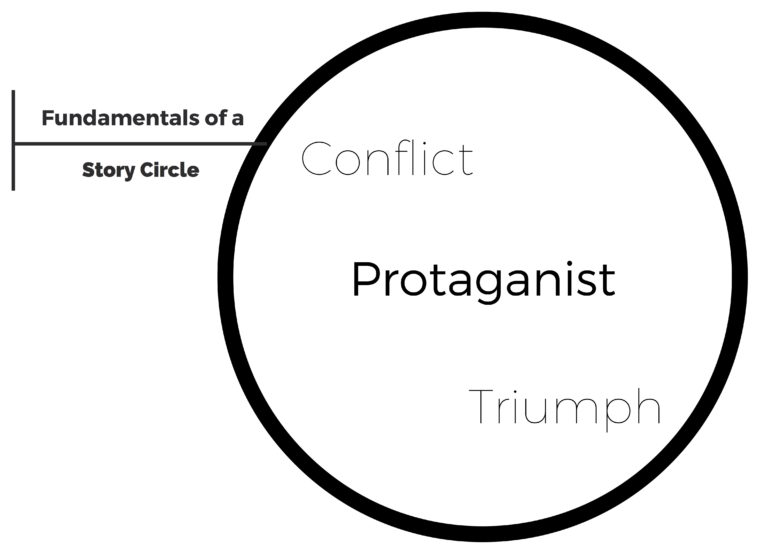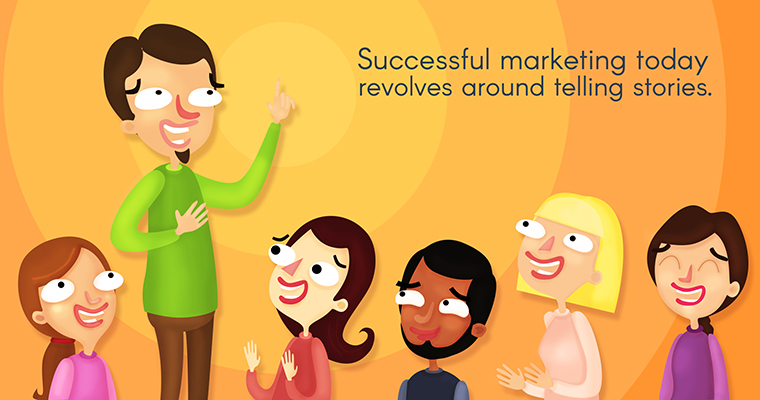Here’s a general question for you. What lasts, in our world?
What really and truly stands the test of time, avoiding the cosmic laws of entropy and decay?
It sure isn’t capacitive touch screens in a home with toddlers; I’ll tell you that.
Stories endure.
Guy meets girl, a man out-of-place, rags to riches, the quest, voyage and return; love conquers all – these are lasting tales that have been told since mankind knew how to tell them.
- “Once upon a time…”
- “A long time ago in a galaxy far, far away…”
- “It was the best of times; it was the worst of times.”
- “RAGE. Sing, Goddess, Achilles’ rage…”
- “Hello. My name’s Forrest. Forrest Gump. Do you want a chocolate?”
Stories are immortal.
Why Storytelling?
Why do we tell stories?
American literary scholar Jonathan Gottschall says it’s because we can’t help it.
We have to turn things that aren’t stories into stories, to be able to understand them and accept them. Take any example of the last conversation you had. Which one didn’t include an incident (read: story)? “Guess what happened the other day…” “When John and I…” “On Monday I…”
Frank Rose, the author of The Art of Immersion, says, “We use stories to make sense of our world and to share that understanding with others. They are the signal within the noise.”
In an article in The Atlantic, titled “The Psychological Comforts of Storytelling,” Cody Delistraty writes:
Stories can be a way for humans to feel that we have control over the world. They allow people to see patterns where there is chaos, meaning where there is randomness. Humans are inclined to see narratives where there are none because it can afford meaning to our lives—a form of existential problem-solving.
Understanding, acceptance, control, problem-solving – it appears we tell stories because we have to. To be human and sentient, we need a narrative.
We tell stories because they make us feel. We tell them because they’re thrilling, victorious, heartbreaking, terrifying, thought-provoking, inspiring, and insane.
Take the tales that have survived through out time.
There’s nothing like your first time seeing the Death Star blown to bits. King Lear’s anguish as Cordelia lies dead in his arms (or many, many other Shakespeare tragedies) pulls at our heartstrings in a way few other things do. The story of Jesus has moved billions of people across the globe and throughout history.
History is the story of human experience. That history is told through stories. There is no escaping them.
Stories are so prevalent in our lives that we don’t even see them. Psychologist Robin Dunbar, who teaches at the University of Oxford (yes, that one), says that storytelling “accounts for approximately 65% of [all] speaking time, with only limited variation due to age or gender.”
Stories dominate our speaking time. We read them (though a Smithsonian survey reports that only 73% of Americans read a book last year). And we watch the ever-loving crap out of them.
Why Do We Listen to, Read, and Watch Stories?
Besides the reasons listed in the previous section (i.e. understanding, meaning, etc.), we listen to stories because it’s how our brains work evolutionarily. We have become wired to experience information told to us as if we had been there.
Think about it.
When someone tells you how sweet a cinnamon roll tastes, you can taste it.
That means there are more areas of the brain lighting up than just language and information receptors. Your sensory cortex ignites. You can smell and taste the pastry.
It doesn’t stop there. You can see it in your mind. You can probably smell it, too. But what happens next is what’s remarkable. You probably remember the last time you had one – where you were, who was there, what time it was. Your brain is using a story to fill in the three (or four) dimensions around you.
Here’s the real kicker: stories allow us to practice mind control. Sort of. There’s a more scientific explanation available. Uri Hasson, who teaches at Princeton, describes the power of telling and listening to a story. He describes what he calls “neural-coupling” happening between a storyteller and a story-listener.
Hasson says, “By simply telling a story, the woman [or man] could plant ideas, thoughts, and emotions into the listeners’ brains.” In neural-coupling, the listener receives the story and makes the idea, experience, or concept their own. Now that’s power.
Put a pin in that thought because we’ll be coming back to it shortly.
Storytelling Through The Ages: An Overview
Every article about storytelling will include some reference to ancient caves. Paintings on the walls of caves in France may interest you, but the chances are slim. What you need to understand is not that people have been telling stories since time immemorial.
What you need to know is that everyone has been telling the same stories over and over again.
Homer’s Iliad is predominantly a band-of-brothers war story (along with several other complicated themes).
Romeo and Juliet is a boy-meets-girl tale. Granted it has the twisty boy-meets-girl-oh-wait-suicide! variation to it, but nonetheless it’s a tale as old as time.
The Harry Potter series is mostly an “overcoming the monster” story.
This holds true for visual media as well. Dallas Buyers Club is a rebirth story. Game Of Thrones, for all its scheming and retribution, is mostly a quest story or an “overcoming the monster” tale (Cersei, babe, I’m looking at you). Breaking Bad is just a modern tragedy.
Finding Nemo? Quest. The Godfather? Tragedy. The Wizard of Oz? That’s a voyage and return story like Homer’s Odyssey. Seriously, give me another one – I could do this all day. Fifty Shades of Grey? Comedy. Just kidding.
Anyway, why does it matter that storytelling has been the same through the ages? It matters because you can know exactly how to connect with people. You can know with certainty that what you’re saying is lighting up those areas of the brain that lead to decision-making and self-education.
Again, you can practically perform mind control.
Roots of the New Content Marketing (Sort of): 1800s and John Deere
Everyone is selling something. Whether it’s web design, fiction, ideas, coffee, or anything else, we’re trying to get other people to consume what we’re offering. That’s nothing new. Neither is storytelling in content marketing, by the way.
In the 1800’s, John Deere produced a magazine for farmers across America called The Furrow. It offered editorial content, stories about farming, education on farming techniques, and more. It did NOT sell tractors. It was NOT designed to sell tractors.
The Furrow built a loyal following because John Deere was always present. Discussions of the farming lifestyle, humorous anecdotes, and lessons on farming by subject matter experts made the magazine a host for positive, informational farming content. And it was John Deere that was providing it.
John Deere was creating a relationship with the readers. It was helping them become better farmers—and better people—without commercializing a product or marketing an ounce of machinery.
So if storytelling has been present in content marketing for over a century, is there anything new about it? Have we changed how we use it? Do we even need to be talking about?!
Yes. Because…
Mad Men Days: Advertising Ruined Everything
From the 1950s to the 1970s (the setting for AMC’s Mad Men, one of my fave shows), modern marketing and advertising were created—and it exploded. It was everywhere. And, most importantly, it was the only way that people were receiving information about new products.
Television viewers in California would learn the same thing about what made a new car great as audiences in Virginia. Commuters would hear on their radio why they needed a new vacuum cleaner. “Keeping Up with the Joneses” was a comic strip that ran from 1913-1940. Isn’t it easy to see why this era of the 50s-70s appropriated the idiom?
This style of marketing has since been called interruption marketing. It was mass media advertising invading people’s homes and lives, barking marching orders to buy their products for reasons x, y, and z.
Marketers found ways to interrupt television shows, radio programs, newspapers, magazines, commutes (billboards, etc.), train and bus rides, flights, and nearly every facet of our lives. We’ve been drowning in advertising ever since.
In fact, CBS News reported in 2006 that people were exposed to 5,000 ads a day. If we didn’t sleep, and that figure was spread out evenly across a 24-hour period, it would equal 208 ads an hour—or 3.5 ads every single minute of our lives. Of course, some of us sleep, so those numbers would reveal that our waking hours are even more stuffed with advertising.
That’s exactly why traditional, targeted advertising doesn’t work anymore. It’s a thing of the past.
The New Content Marketing: Today
Why is content marketing fast replacing the old, traditional TV advertising?
Millennials and generations younger than them pick and choose what they want, and ignore everything else. They can easily filter out anything they don’t want to see across all media platforms and electronic devices.
I can’t think of a better way to put it than this. Scott Donaton, of Fast Company, says:
The challenge is clear by now: Intrusive, interruptive, self-centered marketing no longer works the way it once did, and its effectiveness will only continue to diminish in the social age. The question is what will replace the legacy model. There’s a one-word answer: stories.
Daniel Newman, on Forbes, says that millennials “don’t want [something] from a brand, necessarily – they want it from trusted sources – and who’s more trusted than their social communities, and their social communities.”
So, what do we share with one another? What’s our universal language?
Stories.
How to Get it Right Today: Don’t Fall Behind
Companies entrenched in targeted, interruption marketing need to make a change—or they’ll be left behind. The catch is that mobile devices and streaming services have been around for a while now. Many savvy marketers have been aware of this need for change. And, just like our television sets and radios in the post-WWII era, the internet is beginning to get clogged up with ads.
Content Marketing Institute says that “to break through…brands need to tell remarkable stories that are worth listening to…and they are becoming the media in the process.”
What does that mean, “becoming the media?”
Remember Frank Rose and his book The Art of Immersion? Here’s Rose on this very idea:
The internet is the first medium that can act like all media — it can be text, or audio or video, or all of the above. It’s nonlinear, thanks to the world wide web and the revolutionary convention of hyperlinking. It’s inherently participatory — not just interactive, in the sense that it responds to your commands, but an instigator is constantly encouraging you to comment, to contribute, to join in.
One of the trendiest buzzwords in marketing today is “influencer.” In its absolute most basic form, an influencer is a reviewer.
Look at sites like Amazon, whose success is predominantly based on user reviews. User reviews and comments are simultaneously the desired word-of-mouth marketing and stories.
Sometimes the reviews themselves become a story, as humorous or particularly harsh reviews go viral and are shared on Facebook or in other social media without the intention of promoting the product at all.
Also, look to the rise of “unboxing” videos on YouTube—or other people playing video games on platforms like YouTube and Twitch. There are thousands of these kinds of videos on the internet, and they receive millions of views. Some have even given rise to internet celebrity personas with huge sponsorship contracts.
All in all, social media, influencers, testimonials, and word-of-mouth marketing are incredibly successful forms for rapid information distribution and promotion.
3 Key Ways to Win at Storytelling Through Your Content Marketing Today
But how do you get that ball rolling?
The answer: purpose, authenticity, and good storytelling. Let me define more.
1. Purpose
Simon Sinek wrote a bestselling book titled Start With Why. In it, he describes the importance of finding your purpose. A company needs to know why they do what they do. A brand needs to move beyond knowing what they do and how they do it.
Coca-Cola, for instance, knows it’s not just a soda company. Their “Why” could likely be paraphrased by one of their taglines: “Open Happiness.” Coke has sold happiness, fun, and sharing good times with friends and loved ones for decades. They have been killing it in the story department with this message.
2. Authenticity
Modern consumers hate a fake. Social media users will decry, with mob-like mentality, “Photoshop!” when they see a curved line in an Instagram snap of the star-of-the-week. Reviewers online will immediately click the 1-star or no-star rating when the product they received is not what they wanted.
Your story has to be authentic. It’s okay to show vulnerability. It’s okay if you tell us that the idea for your company came from a dream or some crazy place where you were inspired by just about anything—except spiders. Burn all the spiders.
Remember, we want to connect. Just because Star Wars has space travel, light sabers, and midi-chlorians (really, George???), doesn’t mean it’s not authentic. It also has love, family issues, bravery, and a thousand other issues and emotions we connect with.
3. Good Storytelling
Any writing workshop worth its salt (and even those that aren’t) will harp on these three things:

Protagonist, conflict, and triumph.
Your story doesn’t have to be a tale of swashbuckling adventure and daring rescues. Even if your business is service-oriented or idea-based, you can tell a good story.
An IT company that provides security services can tell a story of nefarious cyber evil-doers, how they have personally affected someone’s life with identity theft, and how they now protect people from that ever happening again, example:
- Protagonist (IT Company) +
- Conflict (nefarious cyber evil-doers) +
- Triumph (internet and identity safety).
Conclusion: Tell Me a Story
Targeted, interruptive advertising is not a lasting game.
It’s time to invest in real content, content that matters.
Eventually, everyone will catch on to the storytelling content marketing revolution. Then, as they do, the digital marketing space will become even more crowded.
And then a new form of marketing and advertising will arise.
But one thing will always be able to cut through the clutter…
Stories. Stories are immortal.
Image Credits
Featured Image: Image by Julia McCoy/ExpressWriters. Used with permission.
In-post Photo: Image by Julia McCoy/ExpressWriters. Used with permission.





